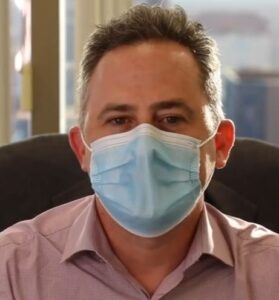
In video message, Jason Kamras tells Richmond Public Schools community that teachers are burning out.
by James A. Bacon
A student at a Petersburg public school took a knife to school Tuesday and used it to cut a classmate from his earlobe to his face, reports the Associated Press.
The perp and the victim were six years old.
While that particular horror was unique to Petersburg, fights and violence are on the upswing in many Virginia public schools this school year, especially in schools where the student bodies are dominated by African Americans. Most incidents never make it into the news. But disorder in the schools has become so widespread that it is causing teacher burnout. Most teachers signed up for idealistic reasons, not to disarm knife-wielding six-year-olds.
What we’re seeing is the manifestation of social breakdown caused by the confluence of three megatrends. One is the impact of closing schools last year due to COVID-19 and attempting, largely unsuccessfully, to teach poor minority kids through distance learning at home where many were left inadequately unsupervised. A second is the social upheaval triggered by the George Floyd killing and the spread of the conviction that America’s institutions, including schools, are systemically racist and that White teachers are ill equipped to deal with Black-White cultural differences. A third is the watering down of school disciplinary policies, in which school districts have adopted a therapeutic approach to dealing with misbehavior. The bar has been raised so high for punishing students that more disruption and disorder is tolerated than ever before.
In a recent message to the Richmond Public School community, Superintendent Jason Kamras announced the closing of schools several days in November to create “mental health days” for the teachers.
“Over the last couple of weeks, I’ve heard directly from dozens of teachers, principals, and support staff about how stressful this year has been,” he said. “Many have shared that they’re on the brink of burning out — even leaving — and it’s only October.”
Kamras is not making this up. I’m not terribly sympathetic because I think that Kamras has spearheaded the wrong-headed policies in Richmond schools that have made the situation immeasurably worse. But he’s not wrong about the terrible morale.
For starters, school systems are understaffed. Many teachers decided not to return. Fear of COVID appears to be a big motivator, although some teachers may be leaving to work in private schools or even as home-school tutors. When schools are understaffed, remaining teachers have to double up on classes, adding significantly to their workload. Add to that, especially in inner-city schools, the fact that half or more of the student population was socially promoted. Shocking numbers of students failed to achieve mastery of basic subject matter tested in the Standards of Learning (SOL)) exams — a fact that Kamras calls “heart breaking” — but they were pushed up to the next grade regardless. Now teachers are being asked to help them catch up — in effect packing two years of instruction into one. Meanwhile, teachers are being asked to cope with increasing levels of disruption and disorder. To put it bluntly, some public school systems are in melt-down mode.
Kamras is not about to admit any of this. (Needless to say, we hear no acknowledgement of these unpleasant realities from the Northam administration.) Here’s how the superintendent explained plummeting teacher morale in his letter:
Some of the stressors are beyond our immediate control. Chief among these is the toll that COVID-19 has taken on our community. Many staff members are still mourning the loss of loved ones; others are still caring for those who are ill. In addition, many spouses and life partners of our employees have lost their jobs and are struggling to find their footing.
He went on to state that some stressors are within the control of the schools: doing too much, teachers not having enough time, and students “exhibiting significant trauma from the past 20 months.” To cope, he said, he will curtail new programs, initiatives or changes in curricula. “If something’s not already in place, it won’t be added this year. Period. In addition, I’ve asked the Leadership Team to think through ways we can scale back on non-essential activities. We need to do less better.”
To free up teachers during lunch, Kamras will assign 100 additional lunch monitors, and will ask principals to show more “flexibility” about holding meetings. Further, to address student trauma, he will ask the School Board to reallocate $3 million in federal relief funding toward mental health support.
The last 20 months of COVID have exacerbated the ills of poverty, racism, and gun violence, Kamras said. “Students are exhibiting significant trauma from the past 20 months.”
Those last statements go to the heart of the problem. Kamras and many other educators view the world through a rigid ideology in which poverty, racism and guns are the root causes of social pathology. The changes they have implemented to address “systemic racism” are not responsible in any way for the breakdown. As inner-city schools swirl down the drain, Kamras and his ideological soul mates double down on their disastrous theories, and African-American kids pay the price.


